Copyright © EJMAS 2001. All rights reserved.
Introduction
Around 1900, Kinzo Umeda and his wife Maki left Kumamoto, Japan, for Hawai’i. Umeda first worked on a sugar plantation railway then opened a dairy farm having a herd of 45 cows in the Kapahulu district of Honolulu.
The couple’s son Yukito was born in Kapahulu on January 15, 1925. The boy had five sisters, one of whom was younger, and two brothers. Both of the latter were older, and one was adopted from relatives in Japan.
Following World War II, Yukito, now known as Tommy, became a popular professional boxer, and the following are his recollections.
The article is based on:
Tommy Umeda
I remember helping clean milking stalls from ten or eleven years of age, and from the age of twelve I was milking cows. I hated doing it but Pop said to do it so we did it because we had just one employee who did most of the milking and cutting the grass for the herd. By 1940-1941 I was getting up at 2:30 in the morning to milk cows before going to school. Man, I hated it. By early 1941 feed supply for the herd and bottling supplies were becoming difficult to get because of world conditions so my brother and I begged Dad to sell the farm, but no way would he do it. About this time, the Board of Health said our dairy had to move because it was in what had become a residential district. So instead of moving to a new farm district, my brother and I ganged up on Dad and convinced him to sell the dairy. Boy, it was just in the nick of time because it was just before December 7 when we got rid of the dairy.
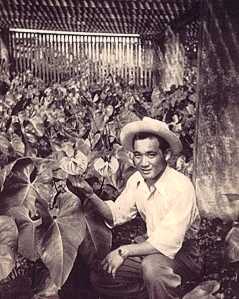
Yukito Umeda at the family farm, pre-World War II.
Photo courtesy Tommy Umeda.
Meanwhile, around 1939 Honolulu’s biggest dairy and the Honolulu Advertiser joined together to start a boxing gym called Boys’ Town Gym. It was in our neighborhood so I started going over there to train. I was fourteen years old at the time. But after two to three months the gym folded and Joe Lynch, a manager/trainer who came over from the mainland to train Hollywood movie stars, bought all the equipment and opened a gym at Bethel Street in downtown and he invited me to come over and start over there. [EN1] I felt good going to Bethel Street because that’s where the pool hall and beer joints were located.
On the morning of December 7, 1941, I was training at the CYO [Catholic Youth Organization] gym, which was on the third floor on the Lady of Peace Cathedral on Fort Street. On the following day, we were to fight the boxing team from Waipahu, which is on the other side of Pearl Harbor, and the Waipahu boys were to come to our gym to weigh-in and get a physical check for our fight. While we were waiting for them to show up we looked out the window and saw the enemy planes flying over Pearl Harbor. The third floor was pretty high in those days.
They didn’t show up so after a while a bunch of us walked mauka [toward the direction of the mountain] on Nuuanu Avenue, and saw where a bomb fell outside the residence of some of our teammates. Later we found out three of our teammates lost their lives to the bombs. [EN2]
So for a while boxing activity at the CYO gym came to a halt.
But with war breaking out there weren’t too many activities going on at night so the professional promoter started putting on Sunday daytime fights. There weren’t enough pro fighters to fill the Sunday afternoon card, so they worked it so that amateur fighters could fill in under the pros. As a result, we started training again.
About this time the Army said that ethnic Japanese fighters could only fight other ethnic Japanese fighters. So I told Bill Kim, the team manager for the CYO club, "I quit." After thinking it over, Bill told me, "You are now Tommy Wong and you’re fighting on Sunday." This is how I got the name "Tommy". [EN3] Everybody knew I was Umeda, not Wong, but nobody cared and I was only sixteen and it didn’t occur to me that maybe I should say this wasn’t right.
When we weren’t fighting on Sunday’s pro card in Honolulu, we fought at Red Hill (a big defense project involving underground fuel storage at Pearl Harbor) and sometimes at Schofield Barracks, Pearl Harbor, Kaneohe Marine Corps Air Station, and other places around the island. We liked fighting at Schofield Barracks, ‘cuz they had the best grub of all bases. During wartime a lot of things were rationed, but up there you could eat all you wanted.
On January 15, 1943 I turned 18. I don’t remember the date when they called for volunteers to form the 442nd Regimental Combat Team, but on March 24, 1943 I was in the Army. I never did graduate from high school.
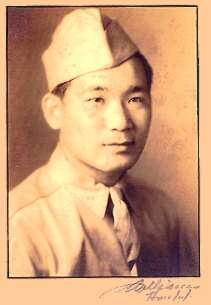
Private Yukito Umeda.
Photo courtesy Tommy Umeda.
During our training at Camp Shelby, Mississippi, we did some boxing at the base gym. [EN4] I was in this fight with a guy from the 69th Division and he started biting my neck. Or at least everybody thought he was biting my neck. Actually he was trying to get his mouthpiece back in. But anyway people piled in the ring and it almost became a real fight. So that was the last time I boxed in the Army.
I was assigned to Company I, which was one of the best units. In Italy, Company I became famous for its involvement in the rescue of that Texas unit, the Lost Battalion, but I was in the hospital, with dysentery. I was very fortunate to miss that one, thank God. [EN5]
Top, left to right: David Kui Kong Young, Eddie Ocasio, Willard
Hauseman.
Bottom, left to right: Tommy Umeda, Tsuneshi Maruo, Shangy Tsukano.
Photo courtesy the Paul Lou Collection.
I returned to Hawai’i in 1945 and started boxing professionally soon after. My managers included Richard "Pablo" Chinen and Henry "Moe" Oshiro, and the promoter who did the most for me was Al Schaff.
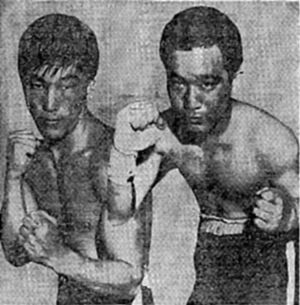
Shangy Tsukano and Tommy Umeda 1946
We fought all over the Territory, going to the military bases, Kauai, Hilo, places like that. A typical purse in those days was fifty dollars. That was nice, but it didn’t pay the bills, so for a job, I worked at Hickam Field as a carpenter. Hell, what do I know about carpentry. So after the first job force reduction, I got my get-lost notice.
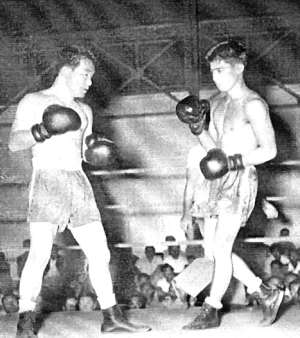
Umeda (left) sparring with Tsuneshi Maruo at the Hilo Armory, 1946.
Photo courtesy the Paul Lou Collection.
Well, I took the hint and sold my contraption, a 1940 Desoto, packed my bags, and got myself a one-way ticket to Seattle. On the plane I sat with a guy going to Anchorage who told me that Alaskan salmon fishermen were making a pile of loot working about eight to nine months of the year. That was enough for me.
withMaruo.jpg)
Umeda (left) sparring with Tsuneshi Maruo, 1946.
Photo courtesy the Paul Lou Collection.
When I got off at Seattle I called my army buddy Shiro Kashino and told him about my plan. He said, "Are you crazy? Everybody there is shooting each other for jobs." [EN6] So the next morning Shiro picked me up at the YMCA where I checked in and he drove me to the Boeing Airplane Company employment office and told me to go in and sign up.
After work, I went straight to the gym to train. I think it was called the Cherry Street Gym, and it was where all the professional boxers trained. Harry "Kid" Matthews was the name fighter in those parts back then.
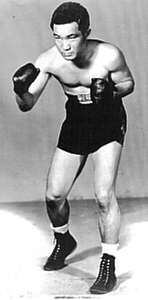
Publicity photo from the early 1950s.
Photo courtesy Tommy Umeda.
I lost one fight out of about sixteen. That loss was to Stan Almond, the Canadian bantamweight champ, during an 8-round fight in Tacoma. Another fight, with Jackie Turner, was ruled a loss at the time. But it was so unfairly scored that three days later the Washington Boxing Commission changed the decision to a draw.
After two months Almond and I got together again for a 10-round fight in Vancouver, British Columbia. Vancouver was his hometown, so you know the chances of a buddhahead winning if the fight went the distance. [EN7] But I beat him anyway.
Around then I ran into Al Schaff, who was in Seattle on his way to Los Angeles. In Seattle they were only paying $50 for a 4-round fight and $100 for a 6-round fight, so I begged Al to get me some fights in Los Angeles.
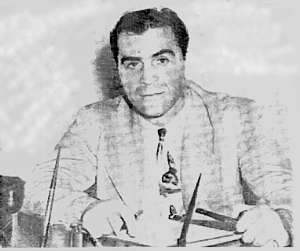
Al Schaff, circa 1950.
Photo courtesy the Paul Lou Collection.
Well, he had connections with the top man in LA, namely Babe McCoy’s nephew, Sparky Rudolph. As for Rudolph’s connections, well, after a couple of fights in LA, I got called for fights in Las Vegas, Anchorage, San Jose, Mexico City…
In October 1951 they sent Freddie "Babe" Herman and me to Australia. I was supposed to fight Jimmy Carruthers, the world’s #1 bantamweight contender, but when I got there they said they never heard of me so they told me to prove myself first. I must fight Bluey Wilkins, a featherweight.
Well, I got myself into the best shape of my life and I beat Wilkins in twelve rounds. After that, Carruthers would have nothing to do with me in the ring.
After a couple months of sitting around, they matched me with Ray Coleman, who was in a weight class higher than me. During this fight, I was ahead on points, but in the seventh my bandage was hanging out of my glove, so I raised my hands to show the referee. I expected him to halt the fight while they fixed my bandage. But the referee said I quit. Bull! I was ahead on points so why would I quit?
After hanging around Australia for five months waiting to fight Jimmy Carruthers, I finally told the promoter to give me my airplane ticket home. Boy, was he glad to see me leave. To think six months later, Carruthers went to South Africa to fight Vic Toweel for the world championship, and won by knockout.
In April and June 1952 I fought Keeny Teran for the California bantamweight championship. The first time I lost, but the second time I knocked him out in seven rounds.
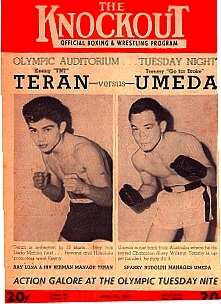
Fight program for the first fight with Teran.
Courtesy Tommy Umeda.
After that I went to Mexico City for a fight and it was called due to a cut. I lost a couple fights due to cuts, but was never knocked out. I think the reason is that I rode the punches. Riding the punches isn’t something you are born knowing how to do, it’s something you learn. You don’t have to have a great punch to be a fighter, but you do need to be clever, to move around. Me, I was a club fighter, a crowd-pleaser, rather than a great boxer. I gave the crowd a good show. That was what I did. And when I couldn’t do that any more I quit boxing.
After retiring from the ring I stayed in California. Usually I worked construction worker but sometimes I worked as an extra in movies. The role everybody has seen is Godzilla (1956). [EN8] The original was filmed and produced in Japan, but the American version included splices of Raymond Burr that were shot in a small studio in LA. I played a Japanese news reporter taking notes while a Japanese professor advised a press conference about plans for getting rid of Godzilla. Actually, I was writing up my scratch sheet for the horse races at Santa Anita, and as soon as the first break was called, I ran to the phone to call my bookie and place a bet.
Around Thanksgiving 1957 I went to New Mexico as the valet for professional wrestler Stanley "Oyama Kato" Mayeshiro. I liked traveling, but that was still rough work. I mean, you had to travel a couple hundred miles a day, every day, including Sundays. Worse, we were the bad guys, what they called heels. So my job was to make people hate us. I’d wear these thick glasses and pull on the referee’s leg and sometimes little old ladies would come from behind and whack me on the back with their handbags. Another time, a little kid put his ice cream cone on my seat while I was walking around harassing the referee. I sat down without looking and gave everyone a good laugh. Meanwhile Mayeshiro treated me like I really was his valet. So when we went back to LA for Christmas I told him to get somebody else. [EN9]
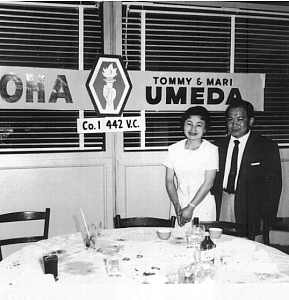
Tommy and Maria Umeda, May 1960.
Photo courtesy Tommy Umeda.
In 1959 I got married. My wife, Maria, was born in Chile, but her family returned to Japan when she was a child. During the early 1960s we had two sons, Allen and Robin. But my parents were getting old, so in 1968 we left LA for Honolulu, as that way I could do a better job of taking care of them. In Hawai’i, I continued working in construction until the late 1980s. After that I worked part-time as a tour guide for Japanese tourists, and then I retired. Well, sort of -- weekdays I help take care of my granddaughter while her mother is at work.
Copyright © EJMAS 2001. All rights reserved.
Umeda’s career record, as posted here, shows 73 professional fights: 30 wins (11 by knockout), 10 draws, 1 no-decision, and 32 losses (5 by knockout). Like most professional boxing records, this one is undoubtedly missing fights, and readers with additions or corrections are invited to contact the editor at jsvinth@ejmas.com.
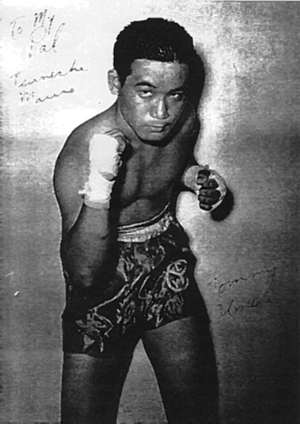
| Date | Opponent | Location | Result |
| 1946 Jun 14 | Kid Waianae | Honolulu | W4 |
| 1946 Jul 12 | Kid Waianae | Honolulu | W4 |
| 1946 Aug 30 | Kid Tarlac (Aceres) | Honolulu | TKO1 |
| 1946 Sep 28 | Louis Rodrigues | Honolulu | W4 |
| 1946 Oct 31 | Henry Davis | Honolulu | L6 |
| 1946 Dec 12 | Henry Davis | Honolulu | TKO by 3 |
| 1947 Feb 28 | Eddie Silva | Honolulu | KO3 |
| 1947 Mar 14 | Victor Sagpang | Honolulu | D4 |
| 1947 Apr 7 | Hideo Tengan | Honolulu | L5 |
| 1947 Apr 18 | Andres Peralta | Honolulu | KO3 |
| 1947 May 9 | Andres Peralta | Honolulu | KO1 |
| 1947 May 13 | Joseph Soares | Honolulu | L6 |
| 1947 May 30 | Billy Herrera | Honolulu | L6 |
| 1947 Jun 27 | Joseph Soares | Honolulu | L5 |
| 1947 Jul 5 | Henry Davis | Maui | TKO by 3 |
| 1947 Aug 1 | Marce Totor | Honolulu | L5 |
| 1947 Sep 5 | Raymond Perera | Honolulu | KO2 |
| 1947 Sep 9 | Placido Torres | Honolulu | L4 |
| 1947 Oct 9 | Marce Totor | Honolulu | W5 |
| 1947 Dec 23 | Gus "Tiger" Rosa | Honolulu | L5 |
| 1948 Feb 3 | Gus "Tiger" Rosa | Honolulu | L4 |
| 1948 Apr 6 | Mike Ines | Honolulu | D5 |
| 1948 Apr 20 | Mike Ines | Honolulu | L5 |
| 1948 Jul 6 | Mamoru Hirota | Honolulu | D4 |
| 1949 Apr 19 | James Nagao | Honolulu | D4 |
| 1949 Sep 20 | Indian Joe Pete | Seattle | W4 |
| 1949 Oct 4 | Pepper Martin | Seattle | D4 |
| 1949 Oct 18 | Jackie Donnelley | Seattle | W4 |
| 1949 Nov 4 | Spider Renaud | Seattle | W4 |
| 1949 Dec 1 | Larry Regan | Seattle | TKO4 |
| 1949 Dec 6 | Mel Eagleman | Seattle | KO2 |
| 1949 Dec 16 | Tommy Rhett | Seattle | W6 |
| 1950 Feb 2 | Indian Joe Pete | Tacoma | W6 |
| 1950 Feb 27 | Jackie Turner | Seattle | D6 |
| 1950 Mar 16 | Hector Marquez | Tacoma | W6 |
| 1950 May 4 | Stan Almond | Tacoma | L8 |
| 1950 Jun 5 | Stan Almond | Vancouver BC | W10 |
| 1950 Jul 12 | Bobby Doll | Spokane | TKO5 |
| 1950 Aug 30 | Larry Regan | Spokane | TKO2 |
| 1950 Sep 13 | Tony Alvarez | Spokane | W6 |
| 1950 Oct 13 | Johnny "Pago Pago" Scott | Seattle | ND3 |
| 1950 Dec | Tony Alvarez | Vancouver BC | W6 |
| 1950 Dec | Jackie Turner | Vancouver BC | W6 |
| 1951 Jan 18 | Tony Alvarez | Vancouver BC | KO5 |
| 1951 Apr 10 | Manuel Hernandez | Los Angeles | D6 |
| 1951 Apr 17 | Manuel Hernandez | Los Angeles | D6 |
| 1951 Apr 24 | Johnny Malloy | Los Angeles | W6 |
| 1951 May 8 | Manuel Hernandez | Los Angeles | W6 |
| 1951 May 22 | Oscar Torres | Los Angeles | W6 |
| 1951 May 29 | Oscar Torres | Los Angeles | W6 |
| 1951 Jun 12 | Johnny Malloy | Los Angeles | L4 |
| 1951 Aug 14 | Bobby Garza | Los Angeles | L |
| 1951 Aug 21 | Keeny Teran | Los Angeles | L6 |
| 1951 Sep 11 | Eddie Hernandez | Hollywood | L4 |
| 1951 Nov 9 | Bluey Wilkins | Melbourne, Australia | L12 |
| 1951 Dec 12 | Bluey Wilkins | Melbourne, Australia | W12 |
| 1951 | Billy Peacock | Australia | L |
| 1952 Feb 4 | Ray Coleman | Sydney, Australia | TKO by 7 |
| 1952 Apr 22 | Keeny Teran | Los Angeles | L10 |
| 1952 Jun 24 | Keeny Teran | Los Angeles | TKO7 |
| 1952 Jul 19 | Edel Ojeda | Mexico City, Mexico | D2 |
| 1952 Aug 19 | Oscar Torres | Los Angeles | L12 |
| 1952 Sep 23 | Otilio Galvan | Los Angeles | L10 |
| 1952 Dec 2 | Oscar Torres | Los Angeles | L12 |
| 1952 Dec 9 | Keeny Teran | Los Angeles | L10 |
| 1953 Jan 13 | Billy Peacock | Los Angeles | L10 |
| 1953 Feb 3 | Billy Peacock | Los Angeles | L10 |
| 1953 Feb 18 | Tanny Campo | Manila | L10 |
| 1953 Mar 15 | Andy Escobar | Manila | D10 |
| 1953 May 26 | Baby Moe Mario | Los Angeles | KO by 9 |
| 1953 Jun 30 | Alex Santoy | San Antonio, TX | L10 |
| 1953 Oct 6 | José Cotero | Los Angeles | L10 |
| 1953 Dec 7 | Oscar Torres | Los Angeles | KO by 6 |
EDITOR’S NOTES
EN1. Richmond "Joe" Lynch was born in New York. At age 17, in 1927, he went to Hollywood, where he worked odd jobs, boxed in bootleg fights, and doubled for actors in movies. In April 1939, he went to Honolulu, where, as noted here, he became a gym owner and small-time fight promoter.
EN2. The three CYO boxers killed were Masayoshi "Freddy" Higa, age 21, Seizu "Paul" Inamine, age 19, and Takao Takefuji, a.k.a. James Koba, age 20; Higa and Takefuji had been scheduled to fight the following day. A fourth boxer present, a professional named Eishin "Toy" Tamanaha, age 24, survived despite having both legs amputated. For additional details, see http://ejmas.com/jcs/jcsart_svinth1_1200.htm.
EN3. There was no 1942 Hawai’i Territorial Golden Gloves tournament, but in 1943, Tsuneshi Maruo, a favorite in the 118-pound division, refused to participate after being told that he would have to fight in the B-division reserved for Americans of Japanese ancestry. To prevent a repetition of this embarrassment, in 1944 the Army prohibited Americans of Japanese ancestry from participating in the contest. For more about Maruo, see http://ejmas.com/jcs/jcsart_maruo_0700.htm; for online photos of wartime Hawai’i, some boxing-related, see http://128.171.57.100/hwrd/HWRD_html/HWRD43.html.
EN4. The Camp Shelby tournament was held in July 1943, and the Camp Shelby Nisei boxers were featured in the September 1943 issue of The Ring (pages 5 and 42). The coaches were PFC Richard Chinen and Private Kenji Nobori. At bantamweight (118 pounds) were Privates Tsuneshi Maruo and Roy Nakamine, and PFC Henry "Moe" Oshiro. At featherweight (126 pounds) were Privates Anki Hoshijo and Yukito "Tommy Wong" Umeda; according to the article, Umeda was "an excellent boxer and is cagey. Much is expected of him." At welterweight (147 pounds) was Private Tsugio "Shangy" Tsukano. Also on the team were Privates Wallace Nagao, Joe Matsunaga, James Hayashi, Shigeo Wasano, Kazumi Tawosaka, Wallace Fukeda, and Richard Kato. See also Star-Bulletin, August 23, 1943.
EN5. During the last week of October 1944, Company I, 3rd Battalion, 442nd Regimental Combat Team, while attached to the 36th Infantry Division, Seventh US Army, suffered heavy casualties during fighting near Bruyeres, France, and it was this meat grinder that Umeda missed due to dysentery. For details of the campaign, see http://www.army.mil/cmh-pg/topics/apam/442.htm; http://www.kwanah.com/txmilmus/36division/archives/lostbat/japanese.htm; http://www.kwanah.com/txmilmus/36division/archives/141/14169.htm; http://www.katonk.com; http://www.nikkeiheritage.org/research/442.html; http://www.homeofheroes.com/moh/nisei/index3_442nd.html; and http://www.ajawarvets.com.
EN6. The youngest of five children, Kashino was born in Seattle on January 19, 1922. Before joining the Army, Kashino played football and sumo. As a platoon sergeant in Company I, 3rd Battalion, 442nd Regimental Combat Team, Kashino received six Purple Hearts, two Bronze Stars, a Silver Star, and a court-martial on trumped-up charges. In 1985 his family convinced Kashino to file an appeal with the Army’s Board for Correction of Military Records, and although Kashino died of cancer on June 11, 1997, on December 9, 1997 his 52-year-old conviction was overturned. For details, see http://members.aol.com/bear317/kashino.txt and http://www.lib.washington.edu/exhibits/harmony/Newsletter/1-9.html.
EN7. Buddhahead is not a religious reference, but instead a pidgin term (buta-head) meaning "pig-headed", and is what Nisei soldiers from the mainland called Nisei soldiers from Hawai’i. The Islanders responded by calling the mainland Nisei kotonks ("stone heads"); the latter term supposedly described the sound of an empty head hitting the ground.
EN8. For an online image of a poster from this movie, see http://www.posterplanet.net/godzillavertcomm.htm.
EN9. The eldest son of Okinawan immigrants to Hawai’i, Shinichi "Stanley" Mayeshiro was born January 7, 1919; his siblings included lightweight boxer Kenyu "Jackson" Maeshiro. (Note different spelling of the last name.) As a young man, Mayeshiro did judo and sumo, and during the early 1950s he moved his wife and seven children to California to begin a career as a professional wrestler. Pseudonyms included Sessue Oyama (after actor Sessue Hayakawa) and Oyama Kato. He wrestled barefoot and pretended to speak only Japanese, but because most of his wrestling was done in the Midwest (especially Ohio), his playing a heel did not embarrass his family. He died of a heart attack following a wrestling match in Vancouver, British Columbia, January 9, 1961, aged 42. Others who played Mayeshiro’s valet "Sugi" included Woody Wakatsuki, whose sister Jeanne Wakatsuki Houston co-authored Farewell to Manzanar (1973).